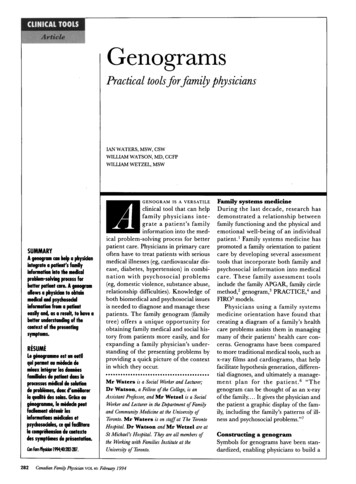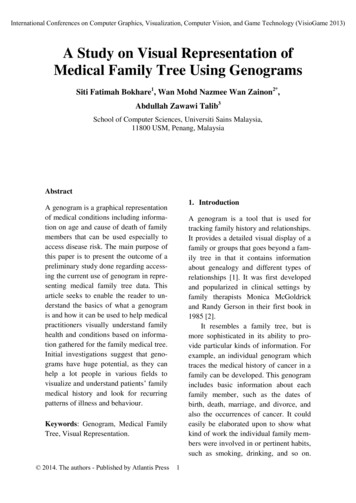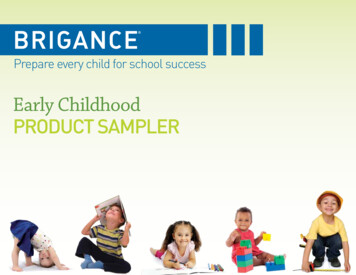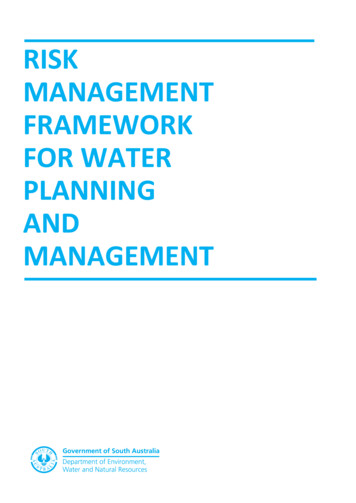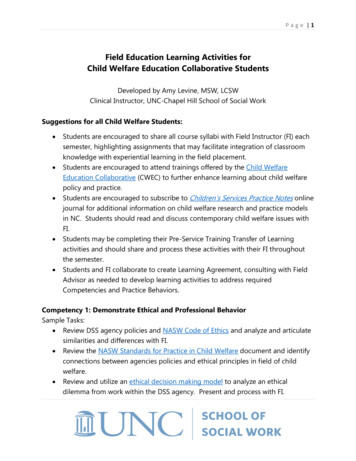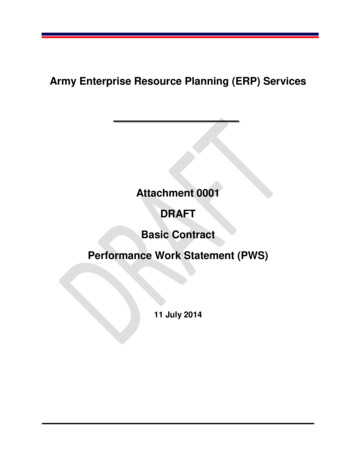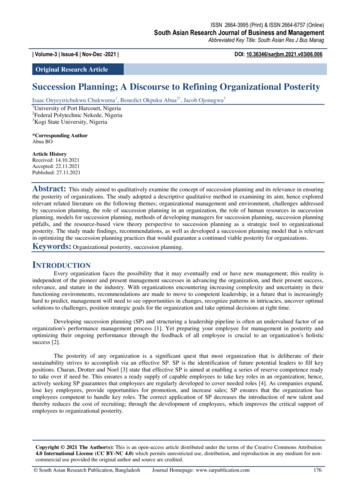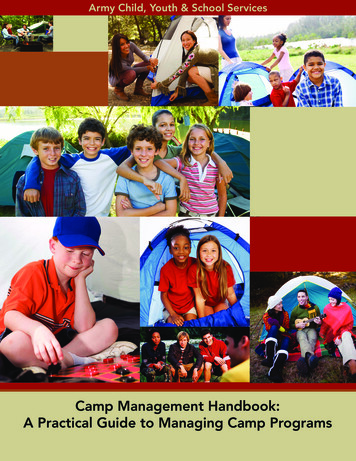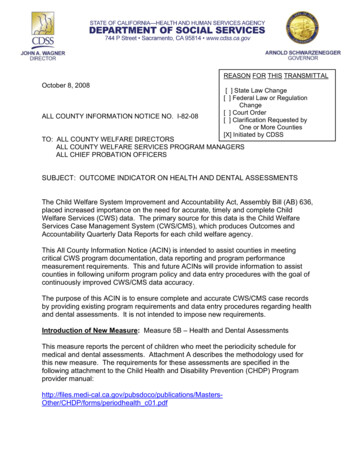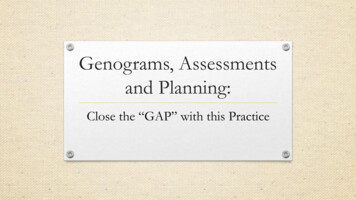
Transcription
Genograms, Assessmentsand Planning:Close the “GAP” with this Practice
Objectives Basics of constructing a genogram Review how to identify the “focus household” members Illustrate other uses for a genogram within child welfare
Genogram Symbols
4 Basic Rules1. The male parent is always at the left of the family and the female parent isalways at the right of the family.2. In the case of ambiguity, assume a male-female relationship, rather thanmale-male or female-female relationship.3. A spouse must always be closer to his/her first partner, then the secondpartner (if any), third partner, and so on.4. The oldest child is always at the left his family, the youngest child is alwaysat the right his family.
Parents
GrandparentsGrandmotherGrandfatherChild 1WifeofChild 11stGranddaughterChild 2HusbandofChild 3Child 31stGrandson
Couple Relationship
Father with Multiple dWifeLiving TogetherThirdPartner
Mother with Multiple RelationshipsThirdPartnerLiving ndOldestBrotherWifeDivorcedMiddle YoungestSisterSister
Creating a Genogram1. Mike’s Family First Mrs. Brady died in 1969 3 boys – Greg (16), Peter (12) and Bobby (10)2. Carol’s Family Mr. Martin was Carol’s first husband and they are divorced. Marsha (15), Jan (11) and Cindy (9)3. Mike and Carol married 1972
Genogram for the Brady Family
FocusHousehold
Focus House CFOP 170-1, Child Welfare Practice Model Chapter 2 – Core Safety Concepts Paragraph 2-3 – Focus of Family Assessment
The family functioningassessment is the processby which information isgathered, analyzed andassessed to determinechild safety in thehousehold where thealleged maltreatmentoccurred.
Definitions “Significant Caregiver Responsibility” means that specific adulthousehold members have taken on responsibility for majorcaregiving responsibilities or it is reasonable to view the person asbeing in a parental role. Things to consider in determining whohas significant responsibility include the following: Household member has routine, day to day care and responsibility forprotecting the child. A paramour residing in or frequenting the home has become a parentfigure.
Definitions “Paramour” means a person who is in a socialrelationship that involves physical or emotional intimacywith a child’s parent or caregiver. The intimate partnermay or may not be cohabitating with the caregiver.
Spot Light vs Honorable Mentionvs
Scenario 1 Marcia Brady-Logan and Wally Logan have been married for 9years. They have two children 4 year-old Ann Logan and 7year-old Molly Logan. Grandma, Carol Brady, lives with her daughter Marcia andWally. She occasionally baby-sits, helps with transportation aswell as with grocery shopping and meal preparations. Marcia and Wally work full-time. Alleged physical abuse took place in home of Marcia andWally.
Scenario 1 Genogram
Scenario 2 Marcia Brady-Logan and Wally Logan were married for 9 years, buthave been divorced for 1 year. They have two children 5 year-old, AnnLogan, and 8 year-old, Molly Logan. Marcia is currently in a relationship with Davy Jones, her high schoolprom date. Molly and Ann have a close relationship with Davy sincethey have spent every weekend together since Marcia and Davy starteddating. Alleged domestic violence took place between Marcia and Davy. Theincident started at the home of Davy. When Marcia left Davy’s home,Davy followed Marcia in his own car. Davy hit Marcia’s car. Bothchildren were in the car with Marcia.
Scenario 2 Genogram
Other uses for a genogram within Child Welfare Pre-Commencement PlanningInitial ConsultationInterview with Children/FamiliesPermanency Round Tables/Permanency PlanningFamily Team ConferencingIndependent LivingAdoption
Questions
Contact Info Hilary Farnum hilary.farnum@brevardfp.orgLisa Brooks Lisa.Brooks@myflfamilies.comLinda Radigan Linda.Radigan@myflfamilies.comErika Summerfield Erika.Summerfield@myflfamilies.com
Resources http://www.genopro.com/
Genogram SymbolsCouple Relationships Symbols
Multiple Marriages by a terSeparatedYoungestSisterSecondWifeLiving TogetherThirdPartnerMultiple Marriages by a FemaleHalfSisterThirdPartnerLiving rcedGrandparent, Parent and Children herMiddle YoungestSister SisterParent and Children GenogramChild 1WifeofChild 11stGranddaughterChild 2HusbandofChild 3Child 31stGrandson
CFOP 170-1, Child Welfare Practice ModelChapter 2, Safety ConceptsPublished 5/20/162-3. Focus of Family Assessment (FFA-Investigation, FFA-Ongoing, Progress Update).a. Purpose. The family functioning assessment is the process by which information isgathered, analyzed and assessed to determine child safety in the household where the allegedmaltreatment occurred. The essential mission of the department is to identify and protectchildren who need safety management and to support the enhancement of caregiver protectivecapacities of the caregiver(s) responsible (treatment/change). The family assessment processprovides a current analysis by the child welfare professional responsible at different points intime, beginning with the Family Functioning Assessment-Investigations. After a case involvingan unsafe child is transferred to ongoing case management, the family assessment isdocumented in the Family Functioning Assessment-Ongoing Services (FFA-Ongoing) andProgress Updates. The role of the child welfare professional is to evaluate and describe in theFFA-Investigation, FFA-Ongoing and Progress Updates how the household functions, includinga clear understanding as to who provides any care, parenting, quality time, and/or discipline forthe children. Every type of assessment serves the purpose of identifying family conditions, howthe children are vulnerable to those conditions, and whether the parent/legal guardian and othersignificant caregiver(s) in the household are able to care for and protect the children (caregiverprotective capacities).b. Definitions.(1) “Household” means a common residence shared by two or more individualswhether related or not. (Rule 65C-30.001, Florida Administrative Code [F.A.C.])(2) “Household Member” means any person who resides in a household,including the caregiver and other family members residing in the home. Household membersare any additional relatives or persons residing in the home, including but not limited to visitorsexpected to stay an indefinite length of time or college students expected to return to the home.(Rule 65C-30.001, F.A.C.)(3) “Legal Guardian” means that the child has a custodian appointed by courtwho has assumed the role of the parent.(4) “Paramour” means a person who is in a social relationship that involvesphysical or emotional intimacy with a child’s parent or caregiver. The intimate partner may ormay not be cohabitating with the caregiver.(5) “Parent” means a woman who gives birth to a child and a man whoseconsent to the adoption of the child would be required under s. 63.062(1), F.S. If a child hasbeen legally adopted, the term “parent” means the adoptive mother or father of the child. Theterm does not include an individual whose parental relationship to the child has been legallyterminated [defined in s. 39.01(49), F.S., Definitions]1
CFOP 170-1, Child Welfare Practice ModelChapter 2, Safety ConceptsPublished 5/20/16(6) “ Household member has routine, day to day care and responsibility forprotecting the child such that:1. The child views such caregiver(s) as one of the primarypersons with the authority for their care; and,2. The caregiver is expected to remain a part of the family unit.(a) A paramour residing in or frequenting the home has become a parentfigure based on one or more of the following:1. Child welfare professional’s observations of interactionsbetween child and paramour.2. Child’s statements about the paramour.3. Statements from other family members or friends who arefamiliar with family functioning.4. The child has a bond with the paramour, even though thehousehold member or paramour may or may not provide any financial support to the family.5. The paramour frequents the home so often that even thoughhe/she denies any care or supervision responsibilities, the person is an authority figure to thechild.c. Focus Household.(1) The family functioning assessment will be developed with a focus on thehousehold in which the alleged child victim’s parent, legal guardian, paramour (residing orfrequenting the home) and/or other adult household member with significant caregiverresponsibility is the alleged person responsible for the maltreatment.(a) The child victim may reside in the household on a full or part-timebasis.(b) If the child’s parents or legal guardians have established separatehouseholds through divorce or separation, only the household where the maltreating parentresides is assessed for danger threats and family functioning. If during the course of anyinvestigation the investigator learns that the child victim’s parent/legal guardian knew about thedanger threat occurring in the home where the maltreatment occurred and was unable orunwilling to take actions to protect the child, a FFA-Investigation on the separate householdmust be developed.(c) When the person responsible for the maltreatment is a courtappointed guardian or custodian and the child’s biological parent is expressing a desire for thechild to be placed back in their care, the following will occur:1. The FFA-I will focus on the household of the guardian orcustodian.2
CFOP 170-1, Child Welfare Practice ModelChapter 2, Safety ConceptsPublished 5/20/162. If the child was placed in the current home as a result of a childprotection investigation, regardless of whether the biological parent entered into and/orcompleted a case plan, the child’s biological parent and household will be assessed in aseparate FFA-Ongoing.3. When there is no history of child welfare system involvement,the child’s biological parent when in a different household will be assessed using the OtherParent Home Assessment.4. When Termination of Parental Rights has occurred and abiological parent wishes to regain custody, requirements as described in 65C-16, Adoptionsmust be followed.(d) One FFA-Investigation, FFA-O or Progress Update will be createdwhen there is a minor child with a newborn or child(ren) in a home that is under an activeinvestigation and there are no allegations of maltreatment against the minor parent. The minorchild who is also a parent must be assessed as a significant caregiver using all of theinformation domains except adult functioning to describe and document the minor parent’sresponsibilities, relationships and how he/she contributes to or is impacted by family conditions.(e) When a child must be removed from a maltreating parent, nonmaltreating parents in a separate household will be assessed using Other Parent HomeAssessment per requirements in CFOP 170-7, Chapter 5.(2) Separate information domains will be developed for each parent/legalguardian and significant caregiver residing in the same household.(3) When more than one family unit resides in the same household, the familyunit wherein the alleged maltreatment occurred will be the focus of one FFA when:(a) The family units clearly function independently from each other assupported by sufficient information gathering and analysis.(b) The two family units may share some or all of the household expensesbut do not have access to or combine family incomes.(c) The children in each family do not view the parent(s) in the other familyunit as having any responsibility or authority over their care.(d) Some child care duties may be shared on occasion.(e) When only one of two family units residing together is the focus of theFFA, the non-focus family members will not be identified as participants.3
CFOP 170-1, Child Welfare Practice ModelChapter 2, Safety ConceptsPublished 5/20/16(4) When two families reside together and share caregiving responsibilities,regardless of the household that is responsible for the maltreatment, a separate FFAInvestigation must be created for each family. When there are allegations of maltreatmentagainst minor parent, a separate FFA-Investigation must be created for the minor parent andhis/her child(ren) and the other parent/legal guardians in the home and their respective children.(a) One FFA-Investigation will include and describe the minor parent as achild victim.(b) One FFA-Investigation will include and describe the minor parent asan alleged perpetrator.(5) Every type of family assessment must include descriptions of all familymembers and persons in the family household and resource network, whether or not they will beidentified as participants in the case plan. The descriptions should be included in the mostappropriate information domain for the parent or significant caregiver, whichever is mostrelevant, as to:(a) Other person’s relationship to the parent and reason for presence inthe home, including family members of any family unit residing in same household.(b) Impact of other person’s presence as to child functioning, adultfunctioning, parenting and discipline/behavior management.(c) Assessment of other person’s background history informationgathered and whether there are patterns of behavior which present safety concerns.4
Scenario 2 Marcia Brady-Logan and Wally Logan were married for 9 years, but have been divorced for 1 year. They have two children 5 year-old, Ann Logan, and 8 year-old, Molly Logan. Marcia is currently in a relationship with Davy Jones, her high school prom date. Molly and Ann have a close relationship with Davy since
